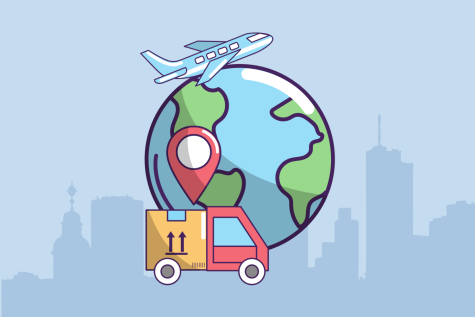Opinion: Full-Time Student, Part-Time Amazon Delivery Driver: Is It Worth It?
Experiences of a COD student and Amazon delivery driver.
February 7, 2022
As a student at COD I work part time while I go to school. Like many students know, it can be difficult to find a part-time job that works around a school schedule, doesn’t consume your entire life and pays enough. One day while I was searching for jobs I hit the jackpot, or so I thought.

I found out about this thing called Amazon Flex. The website said you could work as an independent contractor delivering packages in your own car and work the hours you wanted, and how often you wanted. I decided to try it out. I downloaded the app, went through the background check process and got approved. All I had to do now was schedule a shift and start delivering. On the app, I saw shifts were posted from different warehouses at different times of the day. Shifts were anywhere from 1 – 5 hours long, from any surrounding warehouses.
So, I took my first shift and decided to see what this was about. The app walked me through what to expect, gave me directions to the warehouse I was supposed to pick up from and made me follow a check in process. I walked into the warehouse, and there was a line of other drivers waiting to get a cart of packages to deliver. Like any person on the first day of any job, I expected the warehouse managers might have known that I was a first-time driver and would make sure I knew what I was doing. I quickly found out this was not the case.

I got to the front of the line, was given a cart full of packages and had to roll it to my car in the parking lot as the manager quickly was trying to get to the next person in line. I looked around at what everyone else was doing and put together what I was supposed to do. I figured out the cart included packages that were put together in a way I should have been able to deliver all of them in the amount of time I signed up for. I scanned all the packages with the app and threw all the boxes and envelopes into my car so that I could start delivering. I only had 3 hours. At my first stop I discovered my great mistake in not organizing the packages in the way they were ordered by Amazon according to the order of what stop they were on the route. That day I spent a lot of time looking for packages in my car at every stop. Oddly, the amazon app didn’t, and still doesn’t, make it easy for anyone to organize packages. That shift was supposed to take me 3 hours, but it took 4.5 hours.
I learned if I waited and spent some time in the app constantly pressing refresh, I could work for the same amount of time and make up to $32 more for the same work. This was cool at first, but it became time consuming and stressful because the shifts didn’t always surge or go higher. If they did, sometimes other drivers who are also doing the same thing got the shift first. When I pulled into the warehouses I also noticed some people appeared to be just sitting and waiting. I found out some people knew sometimes the best-paying shifts would appear 1 minute before the start time for the shifts, which no one could possibly make it to in time unless you are sitting in the parking lot of the warehouse anticipating it. I guessed those people might be making the most money but might also be putting a lot of their free time into waiting in the parking lots of warehouses on the off chance they get a high enough paying shift.
If calculated by the length a shift is supposed to take, a shift can pay anywhere from $16 an hour to $40 an hour. Amazon does not explicitly explain to drivers how the pay for shifts is calculated. Generally, shifts seem to pay more when there is a higher demand for drivers. A driver who takes a 3-hour shift that starts in one or two days often will be paid $48. If the driver waits until the start time gets closer, they can be paid up to $90 for the same 3-hour shift and in some cases up to $120 or more. The demand for drivers might increase at early or late hours, when the weather is bad, when other drivers cancel a shift, and when the volume of expected deliveries is high. If completing all the deliveries takes longer than the scheduled time, the driver can choose to return the remaining packages to the warehouse or complete the deliveries and request compensation for the extra time worked from amazon support.

As I got used to delivering, most days the job was easy. Sometimes it was too easy. On those days I would be able to finish all deliveries early. I would take a four-hour shift and the warehouse only had 10 minutes of deliveries to give me. Other times, the warehouse overbooked for drivers and had no deliveries to give me. Though these shifts are uncommon, I still always got paid the full amount I signed up for.
There are some small moments that are fun. One time, I recall walking up to a house and a small girl excitedly ran out the front door to take the package from me while her mom watched. In those cases you’re like Santa all year.
But sometimes deliveries seemed overly difficult. One of the most common experiences I’ve had is delivering from 4 a.m. to 8 a.m. or from 6 p.m. to 10 p.m. I still remember the first time I delivered to a house at 4:30 a.m. There was no light out, and I found not only did the customer turn all their lights off but also their house had no number I could see. There was no way to know I was delivering to the right place. I thought this might be a rare occurrence, but I’ve found it is very common for customers to make delivering to their residence a guessing game. I learned to carry some flashlights with me and be alert at all times. While doing one delivery to what seemed like a normal suburban neighborhood, I was flashing my light around and found a giant spider in the middle of the customers pathway waiting for me. As it has gotten colder, I’ve also had to learn to work in subzero temperatures, how to walk across driveways that are pure ice and/or that are unshoveled.
On the hardest day of doing deliveries, I took a shift from a warehouse in Elgin. It paid a lot, and the Elgin warehouse is only a 20-minute drive with no traffic. Mistakenly, I thought doing deliveries from that warehouse would be the same. I ended up going to a place called Marengo and surrounding areas like Hartland to places I never knew existed. While delivering, it felt like I had stepped into a different dimension.
Houses were separated by miles of unoccupied land. In some cases there were no roads, just dirt or gravel that led to one house or a small group of houses. When it got dark, I learned there was a type of darkness I had never experienced before. Driving in rural darkness with no city lights, not being able to see anything further than my headlights, felt like I was in a horror movie. While it was sometimes terrifying, the people in Marengo were as kind as the people in the northwest suburbs, and the people who were not kind made me feel more uncomfortable than I have ever felt. But that is part of the job and is common no matter where you are delivering. You can get paid higher, and the work can be relatively easy, but you don’t get to choose what area you deliver to or to decline if it’s an area you are unfamiliar with.
Overall, the experience of delivering for Amazon has been mixed. Since Amazon Flex drivers are independent contractors, the money we get paid is self-employment income and is pre-tax. This makes delivering for Amazon Flex more or less worth it. While doing deliveries I’ve been able to see areas I never knew about or took the time to see, and I’ve been able to make some money while still having enough time to go to class and finish homework. There are times that the job is incredibly easy, and there are times the job seems incredibly difficult. But it is a solid source of income in those times that it seems worth it.


















Jeff • Feb 8, 2022 at 11:17 am
Great article! I’m considering getting a job at amazon, but now I’m considering trying flex first before jumping in. Very engaging for the reader!
Jose • Feb 8, 2022 at 11:00 am
This is honestly what I expected from something like Amazon Flex as I have done some other gig economy job stuff myself from Uber to Instacart. Jobs like these are really good when you need something flexible and you don’t have to commit to a classic schedule like most jobs. The only downside is that it can be a lonely job where you do spend a lot of time on your own and I personally need that social interaction among co-workers. Overall, this is a great article and showed me insight on how Amazon Flex works.